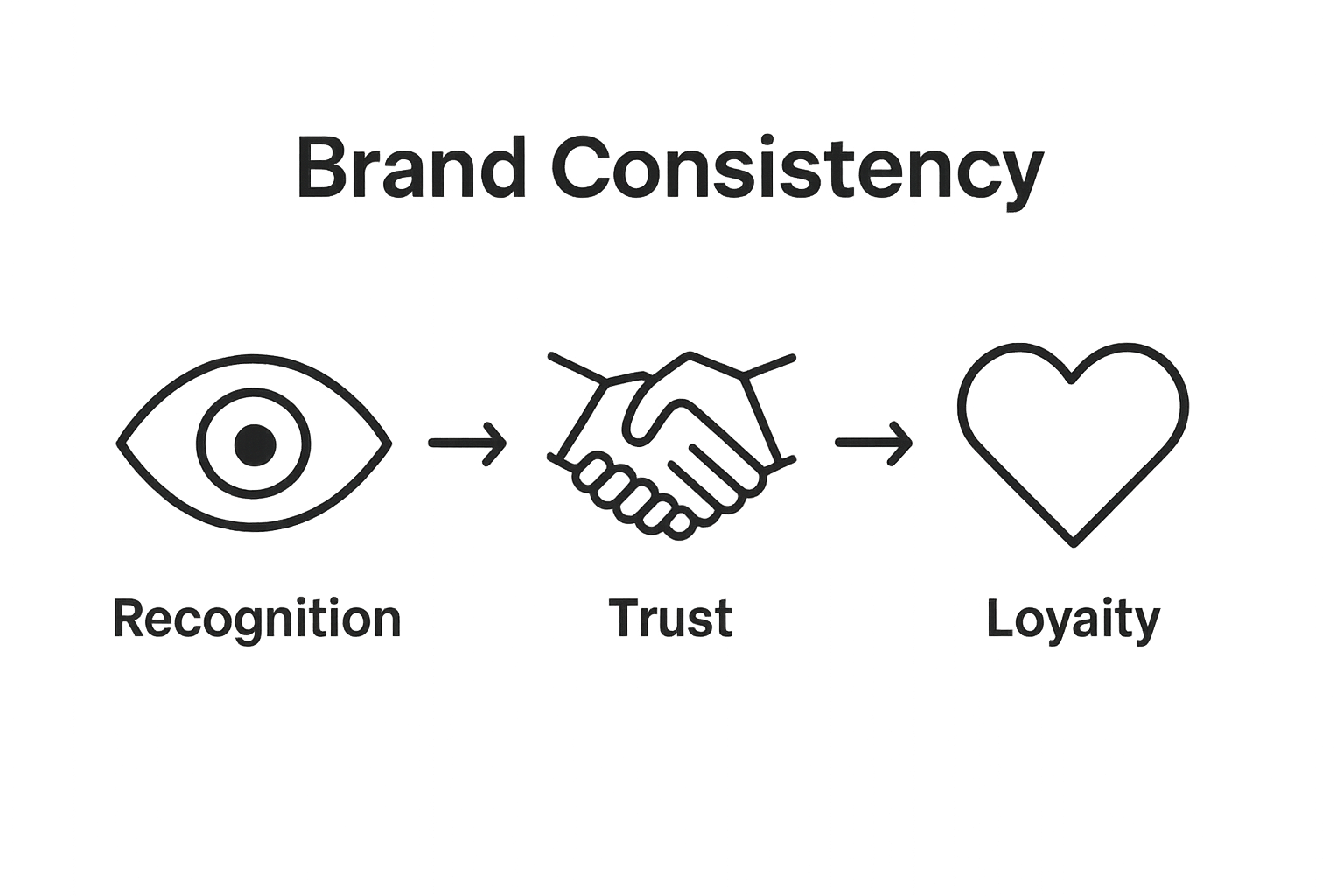Understanding the Importance of Brand Consistency
Brand consistency shapes how customers see your business and decide whether they can trust it. Research shows that customers are 71 percent more likely to buy from a brand they recognize. Most brands chase eye-catching logos and splashy ads hoping that will do the trick. But what really locks in customer loyalty is a steady and familiar message everywhere your brand shows up. The magic is in the details you rarely notice but never forget.
Table of Contents
- What Is Brand Consistency And Its Core Elements?
- The Importance Of Brand Consistency For Customer Trust
- How Brand Consistency Drives Recognition And Loyalty
- Key Concepts Behind Effective Brand Consistency
- Real-World Examples Of Brand Consistency In Action
Quick Summary
| Takeaway | Explanation |
|---|---|
| Brand consistency builds trust and loyalty. | Customers develop stronger emotional connections due to predictable and reliable brand experiences across all platforms. |
| Create comprehensive brand guidelines. | Detailed guidelines help ensure uniform representation even across different teams and communication channels, maintaining a cohesive brand identity. |
| Psychological safety fosters customer loyalty. | Consistent branding generates familiarity and reliability, leading to increased customer retention and positive word-of-mouth. |
| Utilize visual and messaging consistency. | Uniform design elements and communication styles strengthen brand recognition and help customers quickly identify your brand. |
| Incorporate brand training for employees. | Ensuring employees understand the brand’s core values and communication principles helps them represent the brand authentically and consistently. |
What is Brand Consistency and Its Core Elements?
Brand consistency represents a strategic approach where businesses create a unified and recognizable identity across all communication channels and touchpoints. At its core, this concept ensures that every interaction a customer has with a brand feels connected, professional, and authentic.
Below is a table summarizing the core elements that define brand consistency and how each contributes to building a unified brand experience.
| Core Element | Description | Impact on Brand Experience |
|---|---|---|
| Visual Identity | Logo, color palette, typography, and design elements | Promotes instant brand recognition |
| Messaging Tone | Communication style that reflects brand personality | Strengthens emotional connection |
| Core Values | Fundamental principles in all interactions | Builds authenticity and trust |
| Communication Guidelines | Detailed standards for messaging and tone | Ensures clarity across all channels |
| Value Alignment | Consistency between actions and stated principles | Reinforces credibility and loyalty |
Defining Brand Consistency
Brand consistency goes beyond visual aesthetics. According to Marq, it involves aligning an organization’s messaging, voice, and visual identity across multiple platforms. This approach creates a cohesive experience that helps customers instantly recognize and connect with a brand.
Key elements of brand consistency include:
- Visual Identity: Logo, color palette, typography, and design elements
- Messaging Tone: Communication style that reflects brand personality
- Core Values: Fundamental principles consistently represented in all interactions
Why Brand Consistency Matters
Consistent branding builds trust and credibility. When customers encounter a predictable and reliable brand experience, they develop stronger emotional connections and increased brand loyalty. This reliability signals professionalism and commitment to quality.
This table highlights the psychological foundations that link brand consistency to customer trust and perception, helping clarify how various factors work together to establish brand credibility.
| Psychological Factor | Description | Result for Customers |
|---|---|---|
| Predictability | Consistent brand experiences create reliability | Increased confidence |
| Familiarity | Repeated exposure builds brand recognition | Enhanced comfort level |
| Emotional Connection | Uniform messaging reinforces brand personality | Stronger attachment |
| Visual Coherence | Consistent visuals across all platforms | Greater perceived quality |
| Transparency | Genuine, aligned interactions | Heightened sense of trust |
Businesses that maintain strong brand consistency benefit from:
- Improved brand recognition
- Enhanced customer trust
- More memorable marketing interactions
- Stronger competitive positioning
Strategic Implementation
Creating brand consistency requires deliberate planning and comprehensive guidelines. Organizations must develop detailed brand style guidelines that outline exact specifications for visual and communication standards. These guidelines serve as a reference point for all team members, ensuring uniform representation across different departments and external communications.
The Importance of Brand Consistency for Customer Trust
Customer trust represents the foundational element of successful business relationships. Brand consistency plays a critical role in building and maintaining this essential connection, transforming casual interactions into lasting customer loyalty.
Psychological Foundations of Trust
According to research from ResearchGate, brand consistency significantly influences customer perceptions of reliability and credibility. When customers experience predictable and uniform brand interactions, they develop a sense of psychological safety and confidence in the brand.
The trust-building process occurs through several key mechanisms:
- Predictability: Consistent brand experiences create a sense of reliability
- Familiarity: Repeated exposure to consistent brand elements builds recognition
- Emotional Connection: Uniform messaging reinforces brand personality
Impact on Customer Perception
Brand consistency directly transforms how customers perceive and interact with a business. Inconsistent branding signals potential organizational disorganization, while a unified approach communicates professionalism and attention to detail.
Customers subconsciously evaluate brands through multiple trust indicators:
- Visual coherence across platforms
- Consistent communication tone
- Alignment between brand promises and actual experiences
- Transparent and genuine interactions
Long-Term Business Benefits
Establishing trust through brand consistency yields substantial strategic advantages. Companies that maintain a cohesive brand identity experience increased customer retention, stronger market positioning, and more effective marketing communication. By creating a reliable and recognizable brand presence, businesses can differentiate themselves in competitive markets and build lasting customer relationships.
How Brand Consistency Drives Recognition and Loyalty
Brand recognition and customer loyalty represent critical outcomes of strategic brand consistency. Businesses that master this approach create powerful connections that transform casual customers into dedicated brand advocates.
The Psychological Mechanism of Brand Recognition
According to research from ResearchGate, consistent branding generates a neurological response that helps customers quickly identify and remember a brand. This cognitive process occurs through repetitive exposure to uniform visual and communication elements.
Key recognition triggers include:
- Visual Patterns: Consistent color schemes and design elements
- Auditory Cues: Uniform communication tone and language
- Emotional Associations: Predictable brand experiences
Loyalty Development Through Consistent Experience
Customer loyalty emerges from repeated positive interactions that meet or exceed expectations. When a brand maintains consistent quality, messaging, and visual identity across all touchpoints, customers develop a sense of reliability and trust.
Loyal customers demonstrate several characteristic behaviors:
- Increased repeat purchase frequency
- Positive word-of-mouth recommendations
- Higher tolerance for minor service variations
- Emotional investment in the brand’s success
Strategic Implications for Business Growth
Brand consistency transforms recognition into a strategic business asset. By creating a memorable and reliable brand identity, companies can differentiate themselves in competitive markets, reduce customer acquisition costs, and build a sustainable competitive advantage. The cumulative effect of consistent branding results in stronger market positioning and more efficient marketing communication strategies.

Key Concepts Behind Effective Brand Consistency
Brand consistency transcends simple visual design, representing a sophisticated strategic approach that integrates multiple organizational elements to create a unified brand experience. Understanding its foundational concepts enables businesses to develop robust and compelling brand communication strategies.
Internal Brand Knowledge Framework
According to research exploring employee-based brand equity, effective brand consistency begins with comprehensive internal understanding. Employees must deeply comprehend the brand’s core values, messaging principles, and communication expectations to authentically represent the organization.
Key components of internal brand knowledge include:
- Brand Purpose: Clear understanding of organizational mission
- Communication Guidelines: Defined standards for messaging and tone
- Value Alignment: Personal connection with brand principles
Linguistic and Visual Coherence
Brand consistency requires meticulous attention to linguistic and visual details. Every communication channel must reflect a uniform brand personality, ensuring that customers experience a seamless and recognizable interaction across different platforms.
Essential coherence elements involve:
- Uniform color palette
- Consistent typography
- Matching communication tone
- Aligned visual design principles
Strategic Implementation Approach
Successful brand consistency demands a holistic and systematic approach. Organizations must develop comprehensive brand guidelines that serve as a reference point for all internal and external communications. These guidelines should provide clear, actionable instructions for maintaining brand integrity across diverse channels and interaction points, ensuring a cohesive and professional brand representation.

Real-World Examples of Brand Consistency in Action
Brand consistency transforms theoretical concepts into tangible business strategies. By examining successful implementations across different industries, businesses can understand how strategic brand alignment drives customer engagement and organizational success.
Digital Branding Strategies
According to research from the ACM Conference on Web Science, successful digital branding requires maintaining consistent personality traits across various online platforms. Companies that master this approach create memorable and recognizable digital experiences.
Key digital consistency characteristics include:
- Visual Identity: Uniform design elements across websites and social media
- Messaging Tone: Consistent communication style in all digital content
- User Experience: Seamless interaction across different digital touchpoints
Cross-Platform Brand Representation
Successful brands understand that consistency extends beyond visual design. Apple provides an excellent example, maintaining a minimalist, innovative aesthetic across product design, retail spaces, advertising, and digital platforms. Their commitment to simplicity and elegance creates an instantly recognizable brand experience.
Cross-platform consistency elements involve:
- Uniform color schemes
- Consistent typography
- Aligned messaging frameworks
- Coherent visual storytelling
Organizational Brand Integration
Effective brand consistency requires deep organizational commitment. Companies like Coca-Cola demonstrate how a unified brand identity can transcend product categories and geographical boundaries. By maintaining a consistent emotional connection and visual language, these brands create global recognition that resonates across diverse consumer segments.
Ready to Turn Brand Consistency into Growth?
You have seen how vital brand consistency is for building trust and gaining customer loyalty. Yet keeping your messaging, visuals, and voice united across every touchpoint can feel overwhelming. If you struggle to maintain a recognizable and reliable brand, you are not alone. Many e-commerce brands, coaches, and service businesses lose opportunities because customers see mixed signals instead of strong, clear branding.

Now is your chance to stand out. At Take Action Agency, we specialize in fast, results-driven marketing systems that lock in consistency across email, content, and digital advertising. Explore how our Email & Content Marketing Packages can build the trust and recognition your business needs to grow. Book your free strategy call today and let our team show you how to put unified brand consistency at the core of your next stage of growth.
Frequently Asked Questions
What is brand consistency?
Brand consistency refers to a strategic approach that ensures a unified and recognizable identity across all communication channels and touchpoints for a business. This includes aligning visual identity, messaging tone, and core values.
Why is brand consistency important for businesses?
Brand consistency is crucial because it builds trust and credibility with customers. Consistent branding creates predictable experiences, enhances brand recognition, and fosters stronger emotional connections, leading to increased customer loyalty.
How can a company implement brand consistency effectively?
A company can implement brand consistency by developing comprehensive brand style guidelines that outline visual and communication standards. These guidelines should be shared across all departments to ensure uniform representation in internal and external communications.
How does brand consistency impact customer perception?
Brand consistency positively affects customer perception by creating a sense of reliability and professionalism. Customers subconsciously evaluate brands through indicators such as visual coherence, consistent communication tone, and alignment between brand promises and actual experiences.
